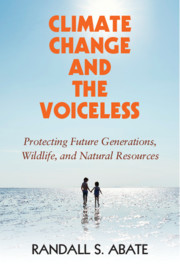Book contents
- Climate Change and the Voiceless
- Climate Change and the Voiceless
- Copyright page
- Dedication
- Contents
- About the Author
- Preface
- Acknowledgments
- 1 An Anthropogenic Problem That Requires an Ecocentric Solution
- 2 Climate Change Litigation in Domestic Courts and Human Rights Commissions
- 3 Protection of Future Generations
- 4 Legal Personhood for Wildlife
- 5 Rights of Nature
- 6 Proposal for Enhanced Stewardship and Rights-Based Protections for the Voiceless
- Subject Index
- Cases Index
2 - Climate Change Litigation in Domestic Courts and Human Rights Commissions
Published online by Cambridge University Press: 28 October 2019
- Climate Change and the Voiceless
- Climate Change and the Voiceless
- Copyright page
- Dedication
- Contents
- About the Author
- Preface
- Acknowledgments
- 1 An Anthropogenic Problem That Requires an Ecocentric Solution
- 2 Climate Change Litigation in Domestic Courts and Human Rights Commissions
- 3 Protection of Future Generations
- 4 Legal Personhood for Wildlife
- 5 Rights of Nature
- 6 Proposal for Enhanced Stewardship and Rights-Based Protections for the Voiceless
- Subject Index
- Cases Index
Summary
Creative climate change litigation has raised awareness of the human rights dimensions of climate change impacts and highlighted the deficiencies of the existing domestic and international regulatory regimes to address climate change. The Inuit petition, submitted to the Inter-American Commission on Human Rights (IACHR) in 2005, marked the beginning of this movement to hold public and private actors accountable for their contributions to climate change impacts and their failure to act (or at least to act adequately) to address the problem. A line of public nuisance cases was pending in US courts while the Inuit awaited the decision on its petition. This line of cases initially sought injunctive relief for climate change mitigation, but subsequently sought damages from private companies for their greenhouse gas emissions. The Kivalina case sparked the climate justice movement in this regard, where a small and remote Native Alaskan community sought damages under a public nuisance theory for the cost of relocation as a result of severe coastal erosion that caused its homeland to become imminently uninhabitable.
- Type
- Chapter
- Information
- Climate Change and the VoicelessProtecting Future Generations, Wildlife, and Natural Resources, pp. 17 - 42Publisher: Cambridge University PressPrint publication year: 2019

